oil pressure AUDI RS7 SPORTBACK 2015 Owners Manual
[x] Cancel search | Manufacturer: AUDI, Model Year: 2015, Model line: RS7 SPORTBACK, Model: AUDI RS7 SPORTBACK 2015Pages: 302, PDF Size: 74.76 MB
Page 5 of 302
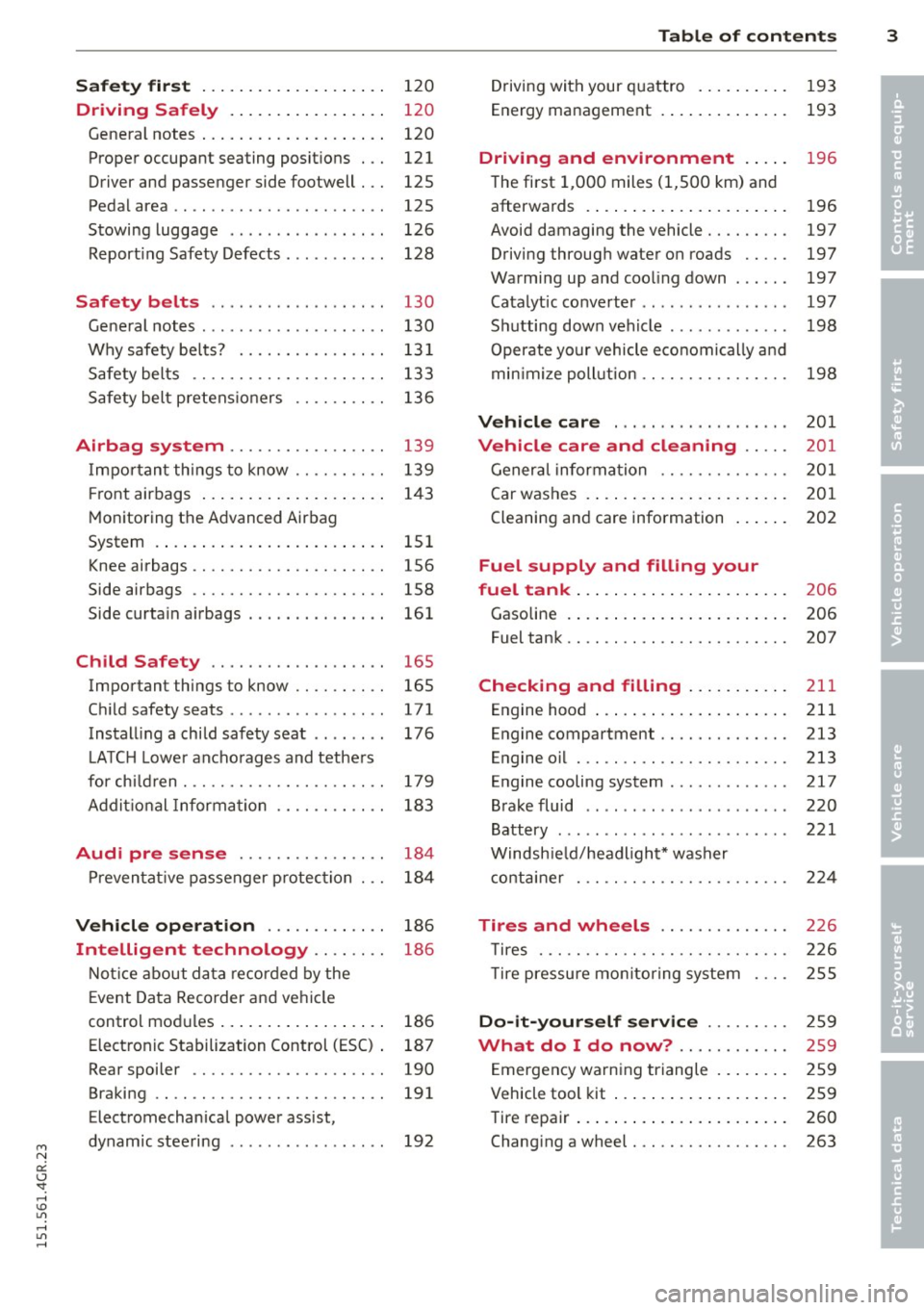
M N
0:: <.J 'SI: ,...., \!) ..,.,
,...., ..,., ,....,
Safet y fir st . . . . . . . . . . . . . . . . . . . . 120
Driving Safely . . . . . . . . . . . . . . . . . 120
General notes . . . . . . . . . . . . . . . . . . . . 120
Proper occupant seating posit ions . . . 121
Driver and passenger side footwell . . . 125
Pedal area . . . . . . . . . . . . . . . . . . . . . . . 125
Stowing luggage . . . . . . . . . . . . . . . . . 126
R eport ing Safety Defects . . . . . . . . . . . 128
Safety belts . . . . . . . . . . . . . . . . . . . 130
General notes . . . . . . . . . . . . . . . . . . . . 130
Why safety bel ts? .. .. .. .. .. . . .. . . 13 1
Safety belts . . . . . . . . . . . . . . . . . . . . . 133
Safety belt p re tens ioners . . . . . . . . . . 136
Airbag system . . . . . . . . . . . . . . . . . 139
I mpor tan t th ings to know . . . . . . . . . . 139
Fr ont airbags . . . . . . . . . . . . . . . . . . . . 14 3
M onitoring the Advanced Airbag
System . . . . . . . . . . . . . . . . . . . . . . . . . 151
Knee airbags . . . . . . . . . . . . . . . . . . . . . 156
Side airbags . . . . . . . . . . . . . . . . . . . . . 158
Side curta in a irbags . . . . . . . . . . . . . . . 161
Ch ild Safety . . . . . . . . . . . . . . . . . . . 165
Important things to know .. .. .. .. . .
C hi ld safety seats ............ .... .
Install ing a chi ld safety seat .. .. ... .
L A TC H L ower ancho rages and tethe rs
fo r ch ild ren . ............. .... .. . .
A ddit io nal Informa tion
Audi pre sense .......... .. .. . .
Pr even ta ti ve passe nger p rotec tion
Vehicle operation ....... .. .. . .
Intelligent technology .. .. .. . .
N ot ice about da ta re corded by the
E vent Data Recorder and vehi cle 165
171
176
179
183
184
18 4
186
186
control mo dules . . . . . . . . . . . . . . . . . . 186
Elect ronic Stabilization Control (ESC) . 187
Rear spoiler . . . . . . . . . . . . . . . . . . . . . 190
Braking . . . . . . . . . . . . . . . . . . . . . . . . . 191
Elect romechan ical power assist,
dynam ic steering . . . . . . . . . . . . . . . . . 192
Table of contents 3
Driving with your q uattro . . . . . . . . . . 193
Energy management . . . . . . . . . . . . . . 193
Driving and environment . . . . . 196
T he first 1,000 miles (1 ,500 km) and
afterwards . . . . . . . . . . . . . . . . . . . . . . 196
Avoid damaging the vehicle . . . . . . . . . 197
Driving throug h water on roads . . . . . 197
Warmi ng up and coo ling down . . . . . . 197
Catalytic co nverter . . . . . . . . . . . . . . . . 197
Sh utting down vehicle . . . . . . . . . . . . . 198
Operate your vehicle economically a nd
min imi ze poll ution . . . . . . . . . . . . . . . . 198
Vehicle care . . . . . . . . . . . . . . . . . . . 201
Vehicle care and cleaning . . . . . 201
Gener al infor mation . . . . . . . . . . . . . . 201
Car washes . . . . . . . . . . . . . . . . . . . . . . 201
Cleaning and care information . . . . . . 202
Fuel supply and filling your
fuel tank . . . . . . . . . . . . . . . . . . . . . . .
206
Gasoline . . . . . . . . . . . . . . . . . . . . . . . . 206
Fuel tank. . . . . . . . . . . . . . . . . . . . . . . . 207
Checking and filling . . . . . . . . . . . 211
Engine hood . . . . . . . . . . . . . . . . . . . . . 211
Engine compartment.............. 213
Engine oil . . . . . . . . . . . . . . . . . . . . . . . 213
Engine cooling system . . . . . . . . . . . . . 217
Brake fluid . . . . . . . . . . . . . . . . . . . . . . 220
Battery . . . . . . . . . . . . . . . . . . . . . . . . . 221
Windsh ie ld/headlight* washer
c ont ainer . . . . . . . . . . . . . . . . . . . . . . . 224
Tires and wheels . . . . . . . . . . . . . . 226
T ires . . . . . . . . . . . . . . . . . . . . . . . . . . . 226
T ire pressure mo nitor ing system 255
Do-it -yourself service . . . . . . . . . 2 59
What do I do now? . . . . . . . . . . . . 259
E mergency warn ing triangle . . . . . . . . 259
Vehicle tool kit . . . . . . . . . . . . . . . . . . . 259
T ire repa ir . . . . . . . . . . . . . . . . . . . . . . . 260
Changi ng a wheel . . . . . . . . . . . . . . . . . 263
•
•
Page 14 of 302
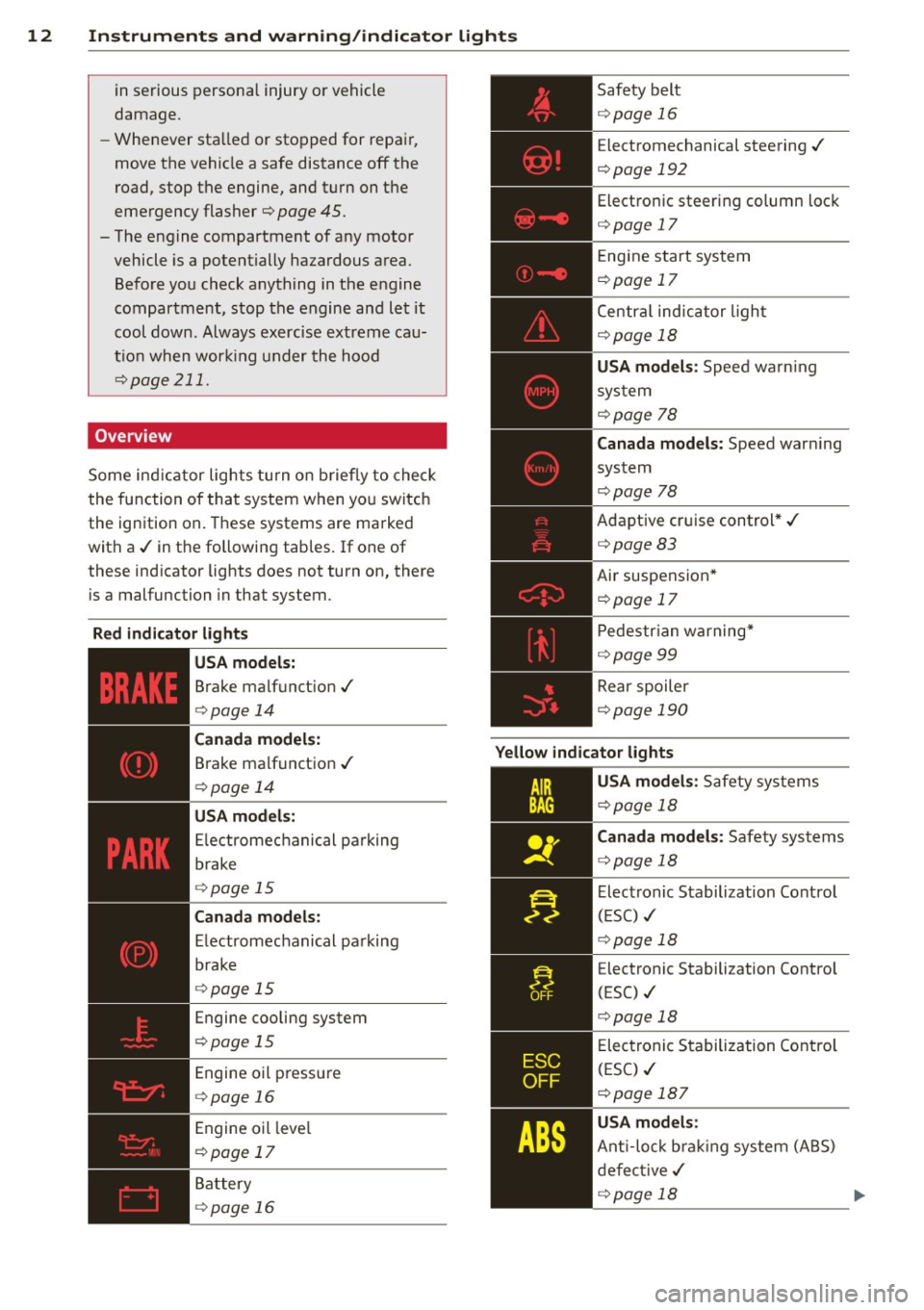
12 Instrum ent s and w arn ing /indic ato r light s
in serious persona l injury or vehicle
damage.
- Whenever sta lled or stopped for repair,
move the vehicle a safe distance off the
road, stop the engine, and turn on the
emergency flasher
¢ page 45.
- The engine compartment of any motor vehicle is a potentially hazardous area.
Before you check anything in the engine
compartment, stop the engine and let it
cool down. Always exercise extreme cau
t ion when wor king under the hood
¢page 211.
Overview
Some ind icator lights tu rn o n briefly to check
the function of that system when yo u switch
the ignition on. These systems are marked
with a ./ in the fo llowing tab les. If one of
these ind icator lights does not turn on, there
is a malfunction in that system .
Red ind icator light s
-------------
USA mo del s:
Brake malfunct ion ./
¢page 14
Safety belt
¢page 16
Electromechanical steering ./
¢page 192
Electronic steering column lock
¢page 17
Engine start system
¢page 17
Centra l indicator light
¢ page 18
USA model s: Speed warning
sys tem
¢ page 78
Canada models : Speed warning
system
¢ page 78
Adaptive cruise control *./
¢page83
Air suspension *
¢page 17
Pedestr ian warning*
~ page 99
Rear spoiler
¢page 190
Canad a mod els :
Brake malfunction ./
¢page 14
Yello w ind ic a to r lights
U SA mo dels:
El ectromechanical pa rking
brake
¢ page 15
Canada model s:
Electromechanical parking
brake
¢ page 15
Engine cooling system
¢page 15
Engine oil pressure
¢page 16
Engine oil leve l
¢page 17
Battery
¢page 16
-------------
USA m odels: Safety sy stems
¢ page 18
Canada mod els: Safety systems
¢ page 18
Electronic Stabilization Control
(ESC) ./
¢page 18
Electronic Stabilization Control
(ESC) ./
¢page 18
Electronic Stabilization Cont ro l
(ESC) ./
¢page 187
USA m odel s:
Ant i- lock bra king system (ABS)
de fect ive ./
¢page 18 ..,.
Page 15 of 302
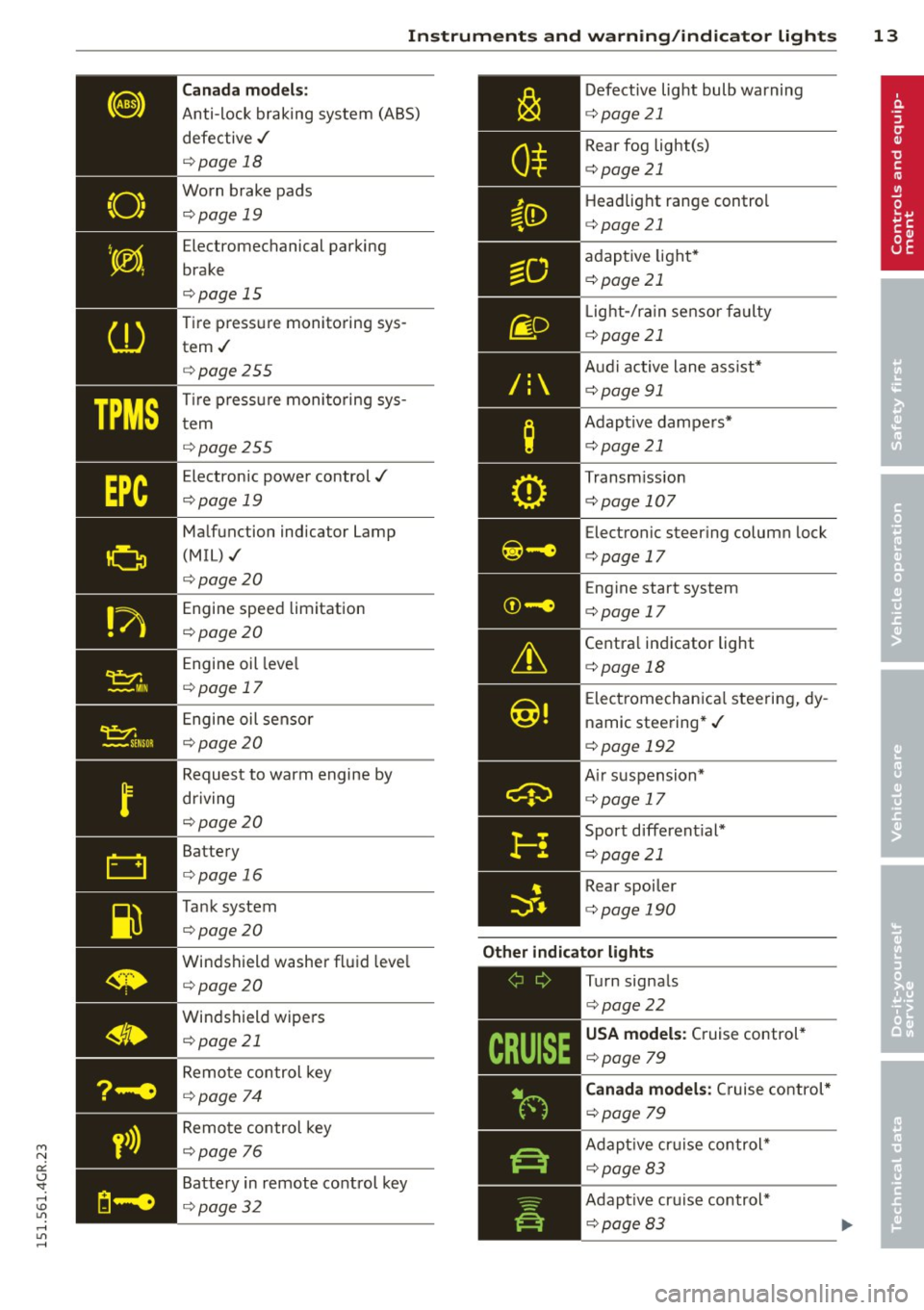
M N
0:: <.J 'SI: ,...., \!) 1.1'1 ,...., 1.1'1 ,....,
Instrument s and warnin g/indic ator ligh ts 13
Canada m odel s:
Anti-lock braking system (ABS)
defective ,/
¢ page 18
Worn brake pads ¢page 19
Electromechanical parking
brake
¢ page 15
Tire pressure monitoring sys tem./
¢ page 255
Tir e p ress ure monitoring sys
tem
¢ page 255
Electronic power control./
¢ page 19
Malfunction indicator Lamp
(MIL),/
¢page 20
Engine speed limitation
¢ page 20
Engine oil leve l
¢ page 17
Engine oil sensor
¢ page 20
Request to warm engine by
driving
¢ page 20
Battery
¢ page 16
Tank system
¢page 20
Windshield washer fluid leve l
¢ page 20
Windshield wipers ¢ page 21
Remote control key
¢ page 74
Remote control key
¢ page 76
Battery in remote control key
¢ page 32
/:
Defective light bulb warning
c:::> page 21
Rear fog light(s)
c:::> page 21
Headlight range control
c:::> page 21
adaptive light*
c:::> page 21
L ight-/ra in sensor fa ulty
c:::>page 21
Aud i active lane ass ist*
c:::> page 91
Adapt ive dampers*
c:::>page 21
Transm iss ion
c:::> page 107
Electronic steering column lock
c:::> page 17
Eng ine start system
c:::>page 17
Centra l ind icator light
c:::> page 18
E lectromechanica l steering, dy
namic steering* ,/
c:::> page 192
A ir suspension*
c:::> page 17
Sport d ifferent ial*
c:::> page 21
Rear spoiler
c:::> page 190
Other indicator light s
-------------
Turn signals
c:::> page22
USA model s: Cruise control *
c:::> page 79
Canada models: C ruise control*
c:::> page 79
Adapt ive cr uise control*
c:::> page 83
Adapt ive cr uise control*
c:::> page 83
Page 18 of 302
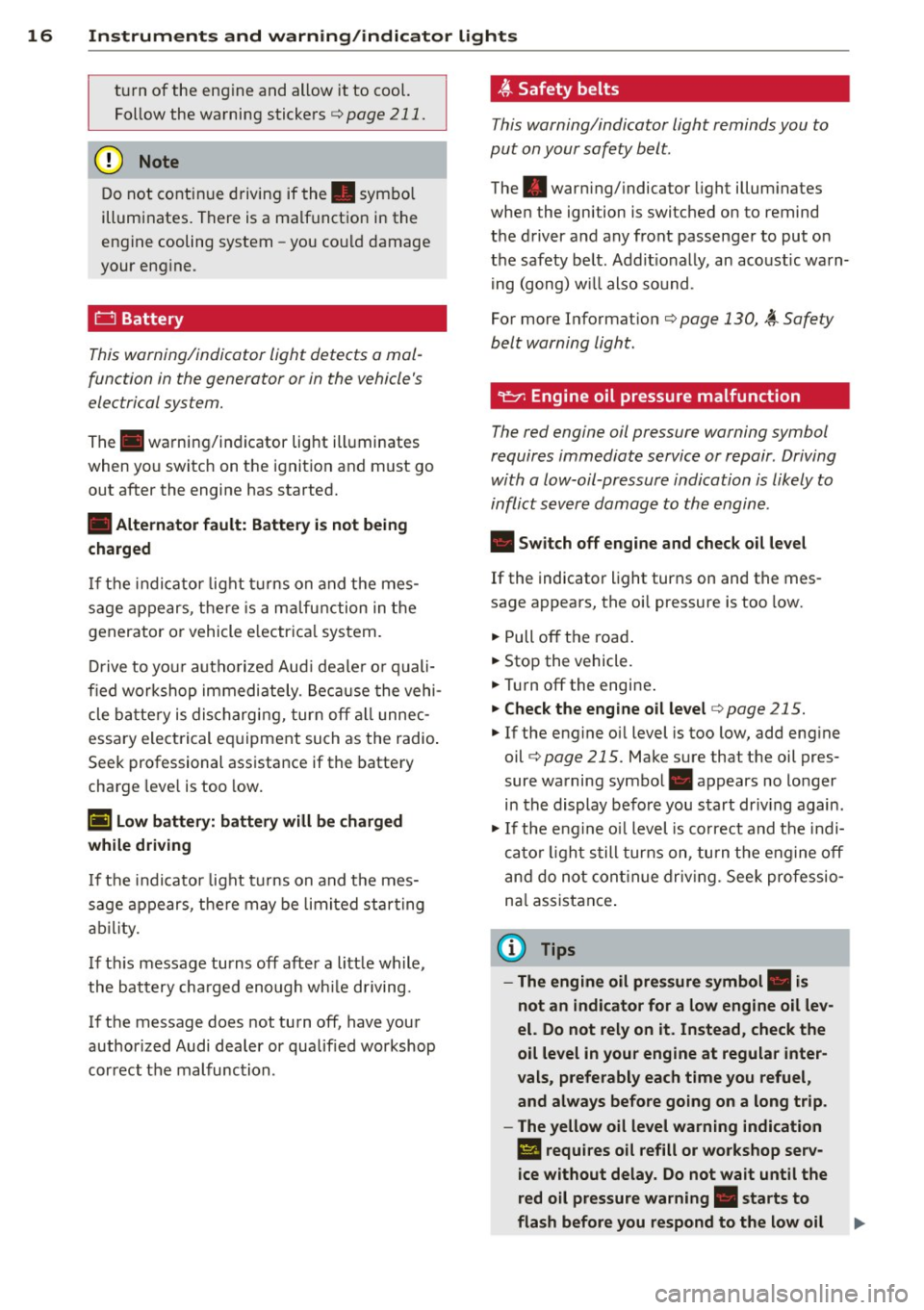
16 Instruments and warning/indicator lights
turn of the engine and allow it to cool. Follow the warning stickers
c::> page 211.
@ Note
Do not continue driving if the. symbol
illuminates. There is a malfunction in the
engine cooling system -you could damage
your eng ine.
0 Battery
This warning/indicator light detects a mal
function in the generator or in the vehicle's
electrical system.
The . warning/indicator light illuminates
when yo u switch on the ignition and must go
out after the engine has started.
• Alternator fault: Battery is not being
charged
If the indicator light turns on and the mes
sage appears, there is a ma lfunction in the
generator or vehicle e lectrica l system.
Drive to you r authorized Aud i deale r or quali
fied workshop immediately. Because the vehi
cle battery is discharging, turn off all unnec
essa ry electrical equipment such as the radio .
Seek professional assistance if the battery
charge leve l is too low.
(•) Low battery: battery will be charged
while driving
If the indicator light turns on and the mes
sage appears, there may be limited starting
ability.
I f th is message turns off afte r a litt le while,
the battery cha rged enough wh ile driving.
If the message does not turn off, have your
author ized Audi dealer or qualified workshop
correct the malfunction .
4'-Safety belts
This warning/indicator light reminds you to
put on your safety belt.
The . warn ing/ indicator light illuminates
when the ignition is switched on to remind
the driver and any front passenger to put on
the safety belt. Addit ionally, an acoustic warn
ing (gong) w ill also sound .
For more Information¢
page 130, ~ Safety
belt warning light.
"l!::7": Engine oil pressure malfunction
The red engine oil pressure warning symbol
requires immediate service or repair . Driving
with a low-oil-pressure indication is likely to
inflict severe damage to the engine .
• Switch off engine and check oil level
If the indicator light turns on and the mes
sage appears, the oi l pressu re is too low.
.,. Pull off the road .
.,. Stop the vehicle.
.,. Turn off the engine .
.,. Check the engine oil level c::> page 21 S.
.,. If the engine o il level is too low, add eng ine
oil
¢ page 215. Make sure that the oil pres
sure warning symbol. appears no longer
in the display before you start dr iv ing again .
.,. If the engine o il level is correct and the indi
cator light still turns on, turn the engine off
and do not continue driving. Seek professio
na l assistance .
@ Tips
- The engine oil pressure symbol. is
not an indicator for a low engine oil lev
el. Do not rely on it. Instead, check the
oil level in your engine at regular inter
vals, preferably each time you refuel,
and always before going on a long trip.
- The yellow oil level warning indication
II requires oil refill or workshop serv
ice without delay. Do not wait until the
red oil pressure warning. starts to
flash before you respond to the low oil ..,.
Page 30 of 302
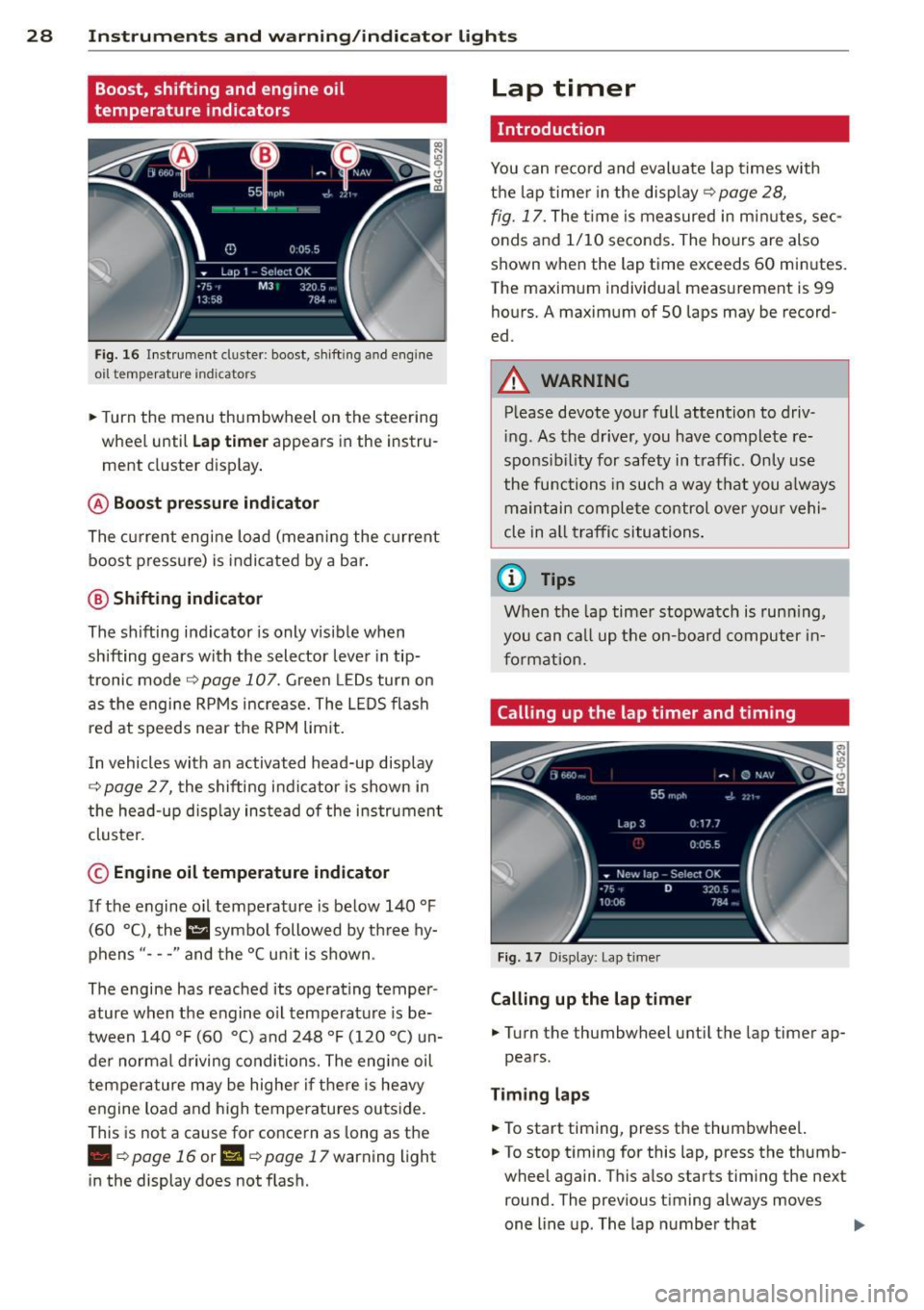
28 Instruments and warning/indicator lights
Boost, shifting and engine oil
temperature indicators
Fig. 16 Instrument duster : boost, shift ing a nd engine
o il t emp erature indicato rs
• Turn the menu thumbwheel on the steering
wheel until
Lap timer appears in the instru
ment cluster display .
@ Boost pressure indicator
The current engine load (meaning the current
boost pressure) is indicated by a bar .
@ Shifting indicator
The shifting indicator is only visible when
shifting gears with the selector lever in tip
tronic mode¢
page 107. Green LEDs turn on
as the engine RPMs increase. The L EDS flash
red at speeds near the RPM lim it.
I n vehicles with an activated head-up display
¢ page 2 7, the shifting indicator is shown in
the head-up disp lay instead of the instrument
cluster.
© Engine oil temperature indicator
If the engine oil temperature is below 140 °F
(60 °(), the l!I symbo l followed by three hy
phens "- - -" and the °C un it is shown .
The engine has reached its operating temper
ature when the engine o il temperature is be
tween 140
°F (60 °() and 248 °F (120 °() un
der normal d riving conditions. The engine oil
temperature may be higher if there is heavy
engine load and high temperatures outside.
This is not a cause for concern as long as the
• ¢page 16 or II ¢page 17 warning light
in the display does not flash.
Lap timer
Introduction
You can record and evaluate lap times with
the lap timer in the disp lay ¢
page 28,
fig. 17. The time is measured in minutes, sec
onds and 1/10 seconds. The hours are also
shown when the lap time exceeds 60 minutes .
The maximum individual measurement is 99
hours.
A maximum of SO laps may be record
ed.
A WARNING
-Please devote your full attention to driv -
in g. As the driver, you have complete re
sponsib ility for safety in traff ic. Only use
the functions in such a way t hat you a lways
maintain complete control over your vehi
cle in all traffic situations .
(i) Tips
When the lap timer stopwatch is running,
you can call up the on-board computer in
formation.
Calling up the lap timer and timing
Fig . 17 D isplay: Lap t imer
Calling up the lap timer
• Turn the thumbwheel until the lap timer ap-
pears.
Timing laps
• To start timing, press the thumbwheel.
• To stop timing for this lap, press the thumb
wheel again . This also starts timing the next
round. The previous timing always moves
one line up . The lap number that
II>
Page 77 of 302
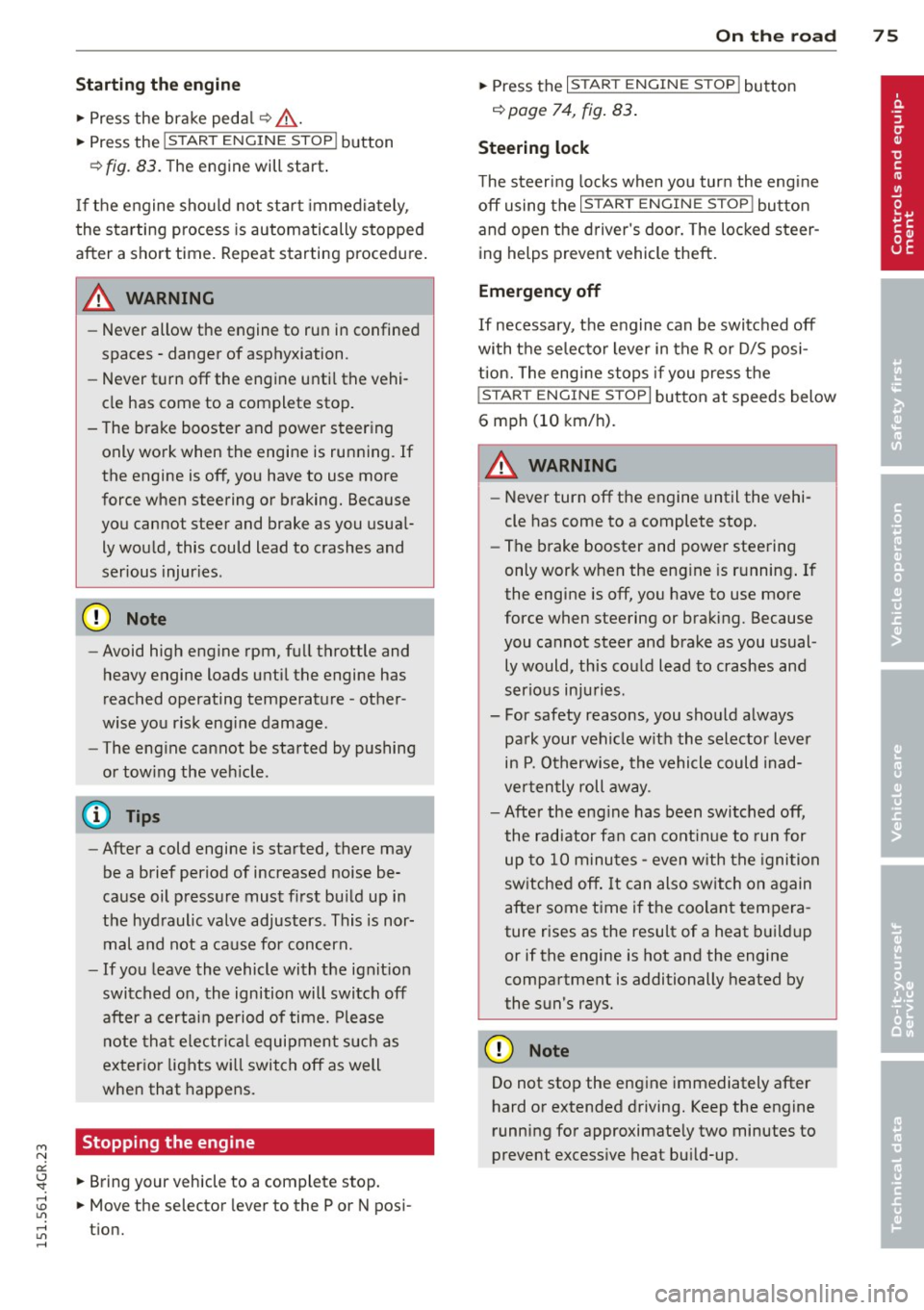
M N
0::
Starting th e engin e
"'Pre ss the brake peda l r::!> _&..
"'Press the I START ENGINE STOP I button
r::!>fig. 83. T he engine will start .
If the engine should not sta rt immediately ,
the sta rting process is automatically stopped
after a short time. Repeat starting procedure .
A WARNING
-Never allow the engine to run in confined
spaces -danger of asphyxiation .
- Never t urn off the engine unti l the vehi
cle has come to a complete stop.
- The brake booster and power steering
only work when the engine is running . If
the engine is off, you have to use more
force when steering or braking. Because
you cannot steer and brake as you usua l
ly would, this could lead to crashes and
ser ious injur ies .
(D Note
-Avoid high engine rpm, full throttle and
heavy engine loads unti l the engine has
reached operating temperature -other
wise yo u risk eng ine damage.
- The eng ine cannot be started by pushing
or tow ing the veh icle.
(D Tips
- After a cold engine is started, there may
be a brief period of increased noise be
ca use oil pressure mus t fi rst bu ild up in
the hyd raulic valve adjusters . This is nor
mal and not a ca use for concern.
- If you leave the vehicle with the ignit ion
switched on, the ignition will switch off
after a certai n pe riod of time. P lease
note tha t electr ica l equipment s uch as
exterior lights wi ll switch off as well
when that happens.
Stopping the engine
~ "' Bring your vehicle to a complet e stop. ,....,
~ "' Move the selector lever to the P or N po si-
,...., tion.
"' ,....,
On th e ro ad 75
"'Press the I START ENGINE ST OP I button
r::!>poge 74, fig . 83.
Ste ering lock
T he s teering locks when yo u tur n the engine
off using t he
I S TA RT ENGINE STO P! bu tton
and open the d river 's doo r. The locked steer
ing helps prevent vehicle theft.
Emergency off
If necessary, the engine can be switched off
with the selector lever in the R or D/S posi
t ion. The engine stops if you press the
I S TAR T ENG IN E ST OP I button at speeds below
6 mph (10 km/ h) .
A WARNING
- Never turn off the engine until the vehi
cle has come to a complete stop.
- The brake booster and power stee ring
only work when the eng ine is r unning . If
the engine is off, you have to use more
force when steering or braking. Because
you cannot steer and brake as you usual
ly would, this co uld lead to crashes and
serio us inju ries .
- For safety reasons , you should a lways
pa rk your vehicle w it h the selector lever
in P. Otherwise, the vehicle could inad
ver ten tly roll away.
- After the eng ine has been switched off,
the radiator fa n can cont in ue to run for
up to 10 minu tes -even with the ignition
sw itche d off . It can also sw itch on again
after some time i f th e coolant tempera
ture rises as the result of a heat b uildup
or if the engine is hot and the engine
compartment is additionally heated by
the sun's rays.
(U) Note
Do not stop the engine immediately after
hard o r extended driving. Keep the engine
running for approximate ly two minutes to
prevent excess ive heat bu ild-up .
Page 214 of 302
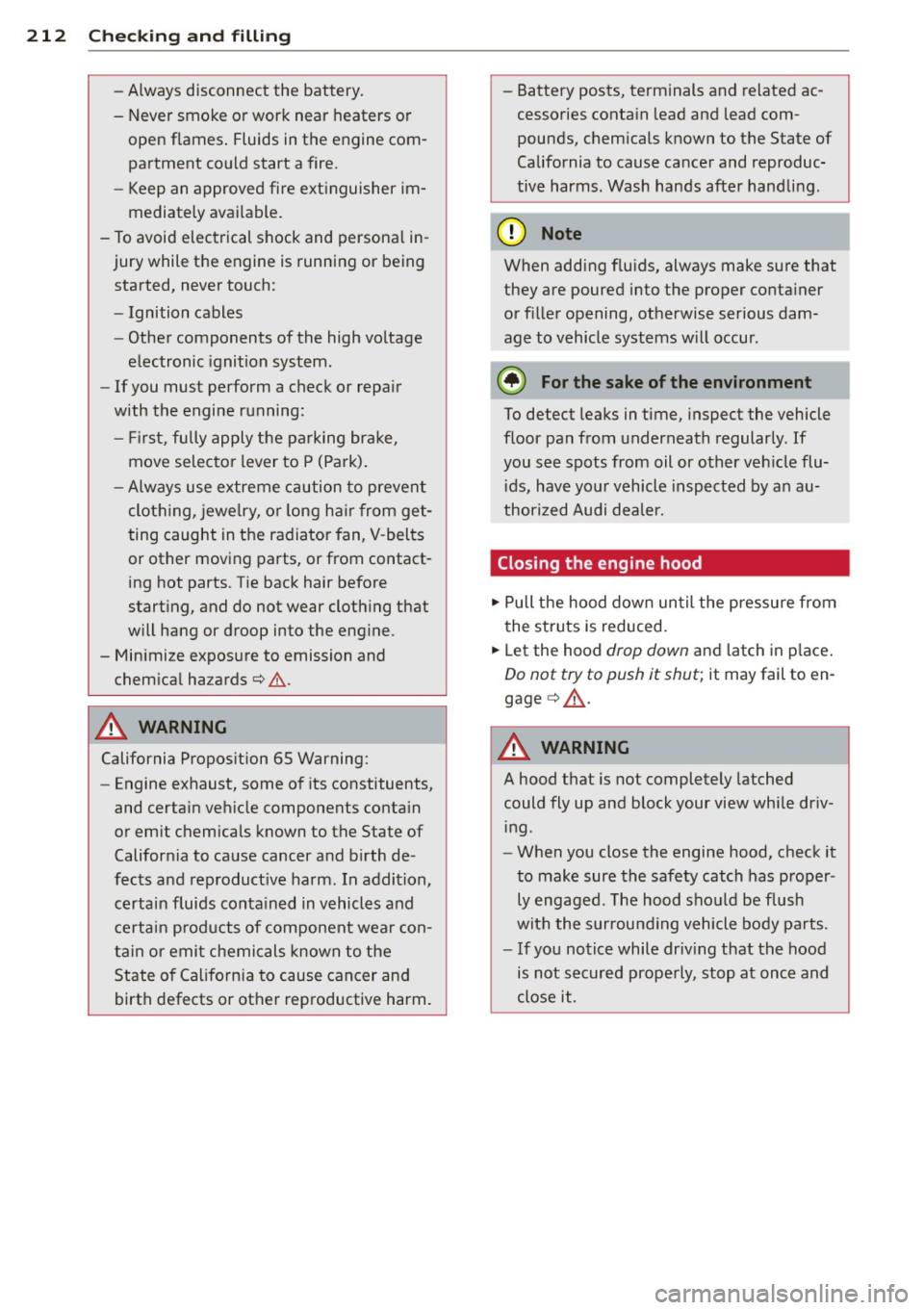
212 Check ing and filling
- Always disconnect the battery.
- Never smoke or work near heaters or open flames . Fluids in the engine com
partment could start a fire.
- Keep an approved fire extinguisher im
mediately available.
- To avoid electrical shock and persona l in
jury while the engine is running or being started, never touch:
- Ignition cables
- Other components of the high voltage
electronic ignition system.
- If you must perform a check or repa ir
with the engine running:
- Fi rst, fully apply the parking bra ke,
move se lec to r lever to P (Pa rk) .
- Always use extreme caution to preven t
clot hing, jewe lry, or long h air from ge t
ting caught in the radiator fan, V -belts
or other moving parts, or from contact ing hot parts. Tie back hair before
start ing, and do not wear cloth ing that
will hang or droop into the eng ine.
- Min imize exposure to emission and
chemica l hazards¢ ,&..
A WARNING
California Propos ition 65 Warning:
- Engine exhaust, some of its constituents,
and certa in veh icle components conta in
or emit chemicals known to the State of
Califor nia to cause cancer and b irth de
fec ts a nd reproduct ive ha rm. In addition,
certain fluids conta ined in vehicles and
certa in prod ucts of co mponent wear co n
ta in o r emi t chemicals known to the
State o f Ca lifornia to cause can cer and
birth defects or ot her reproductive harm. -
Battery posts, terminals and re lated ac
cessories conta in lead and lead com
pounds, chemicals known to the State of
California to cause cance r and reproduc
tive harms. Wash hands after handling .
(D Note
When adding flu ids, always make sure that
they are poured into the proper conta iner
or f iller opening, otherwise serious dam
age to vehicle systems w ill occur.
® For the sake of the environment
To detect leaks in time, inspect the vehicle
floor pan from underneath regularly. If
you see spots from oil or other ve hicle flu
i ds, have yo ur vehicle inspected by a n au
thori zed Audi dea le r.
Closing the engine hood
.,. Pull the hood down un til the pressure from
t he struts is reduced.
.,. Let the hood drop down and latch in p lace .
Do not try to push it shut; it may fail to en
gage ¢&_ .
A WARNING
-
A hood that is not completely latched
could fly up and b lock your view while dr iv
ing.
- When you close the engine hood, check it
to make sure the safety catch has p roper
ly engaged. The hood sho uld be flush
with the surrou nding vehicle body pa rts.
- If you notice while driv ing t hat the hood
is not s ecured prope rly, stop at onc e and
close it.
Page 216 of 302
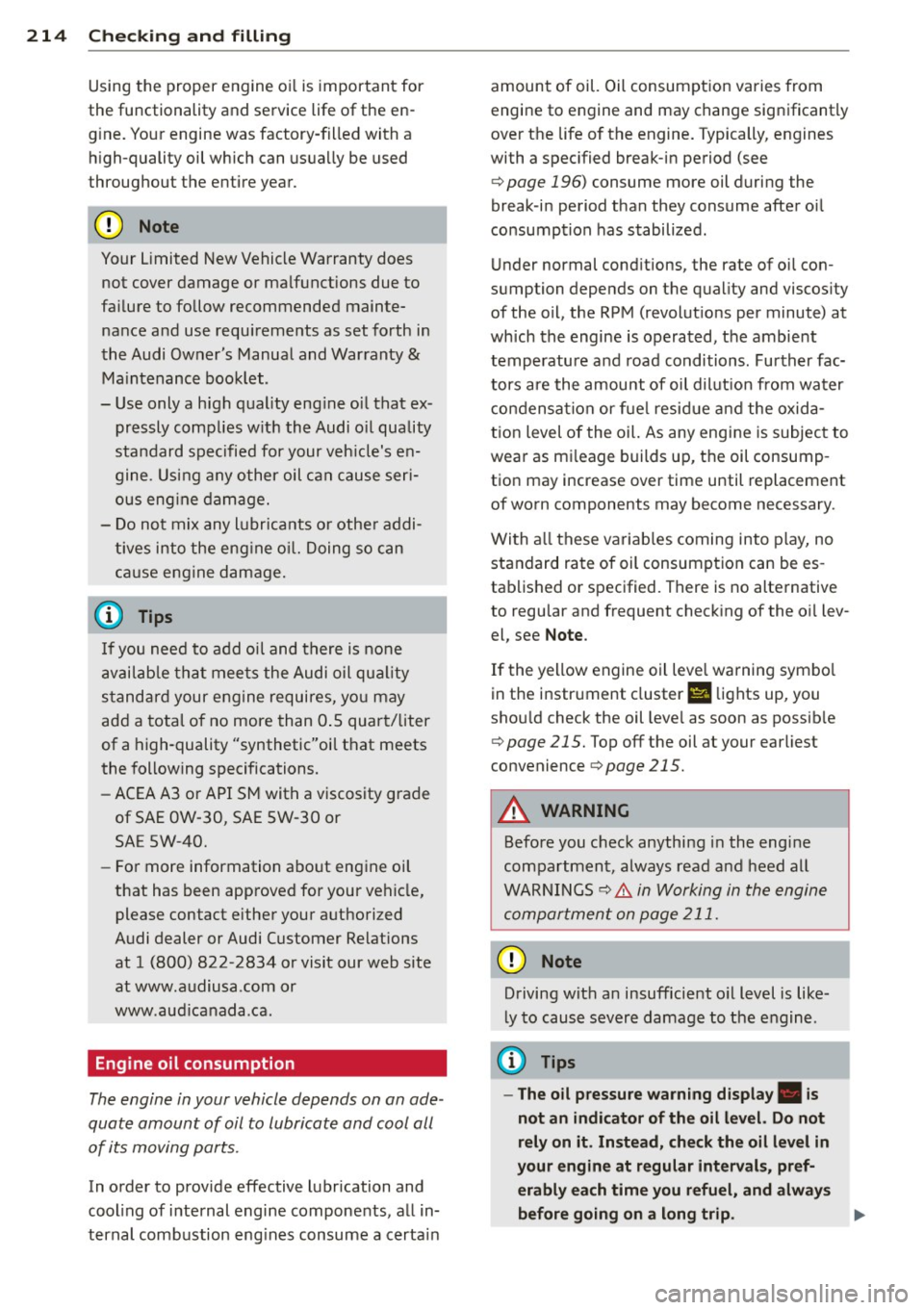
214 Check ing and filling
Using the proper engine o il is important for
the functionality and service life of the en
g ine . Your engine was factory-filled with a
hi gh-quality oil which can usua lly be used
throughout the enti re year.
0 Note
Y our Limited New Vehicle Warranty does
not cover damage or ma lf u nctions due to
fa ilure to follow recommended mainte
nance and use requ irements as set forth in
the Audi Owner's Manual and Warranty
&
Ma intenance boo klet.
- Use only a high quality eng ine oi l that ex
pressly complies w ith the Audi o il quality
sta ndard spec ified for your veh icle's en
gine . U sing any other oil can cause seri
ous eng ine damage.
- Do not mix any l ubr ica nts o r othe r addi
tives into the eng ine o il. Doing so c an
ca use eng ine dam age.
I f you need to add oi l and there is no ne
availab le tha t mee ts the Audi o il qua lity
s tandar d your engine requires, yo u may
ad d a tota l of no more than 0 .5 quart/liter
of a high-quality "synthetic"oil that meets
the following specifications.
- ACEA A3 or API S M with a viscosity grade
of SAE 0W-30, SAE SW-30 or
SAE SW -40.
- Fo r more information abo ut engine oi l
that has been app roved for your vehicle,
please contact either your a uthori zed
Audi dealer or Audi Customer Relations
at 1 (800) 822 -2834 or visit our web site
at www.audiusa .com or
www .aud icanada .ca .
Engine oil consumption
The engine in your vehicle depends on an ade
quate amount of oil to lubricate and cool all
of its moving parts.
In order to provide effective lubrication and
cooling of i nternal engine components, a ll in
ternal comb ustion eng ines consume a certa in amount of oil. Oil consumpt
ion varies from
engine to engine and may change significant ly
over the life of the engine . Typically, engines
with a spec ified break-in period (see
<=> page 196) consume more oil during the
break -in pe riod than they consume after o il
co nsump tion has stabilized.
Under normal cond itions, the rate of oil con
sumption depends on the q ua lity and viscos ity
of the oil, the RPM (revolut ions per minute) at
wh ich the engine is operated, t he ambie nt
temperature and road conditions . Fur ther fac
tors a re the amount of oil dilut ion from wa ter
condensation or f ue l resid ue and the oxid a
t ion level of the o il. As any engine is subjec t to
wear as m ileage builds up, t he oil consump
tion may increase over time until replacement of wo rn components may become necessary.
W it h a ll these variab les coming into play, no
standard rate of oil consumption can be es
tablished or specified. There is no alte rnative
to regu lar and frequent check ing of the o il lev
el, see
Note .
If
the yellow engine oil level warning symbo l
in the instrument cluster
I!!! lights up, you
shou ld check the oil leve l as soon as possib le
<=> page 215. Top off the oil at your earliest
convenience
<=> page 215.
A WARNING
-Before you chec k anythi ng in the engine
com partment, always read a nd heed all
WAR NIN GS¢
& in Working in th e engine
compar tment on page 211.
{(D Note
Driving w it h an insufficient o il level is like
ly to cause severe damage to the engine .
(D Tips
- The oil pressure warn ing display. is
not an indicator of the oil level. Do not
rely on it . Instead, check the oil lev el in
your engine at regular intervals , pref
erably each time you refuel, and alway s
before going on a long trip. .,.
Page 220 of 302
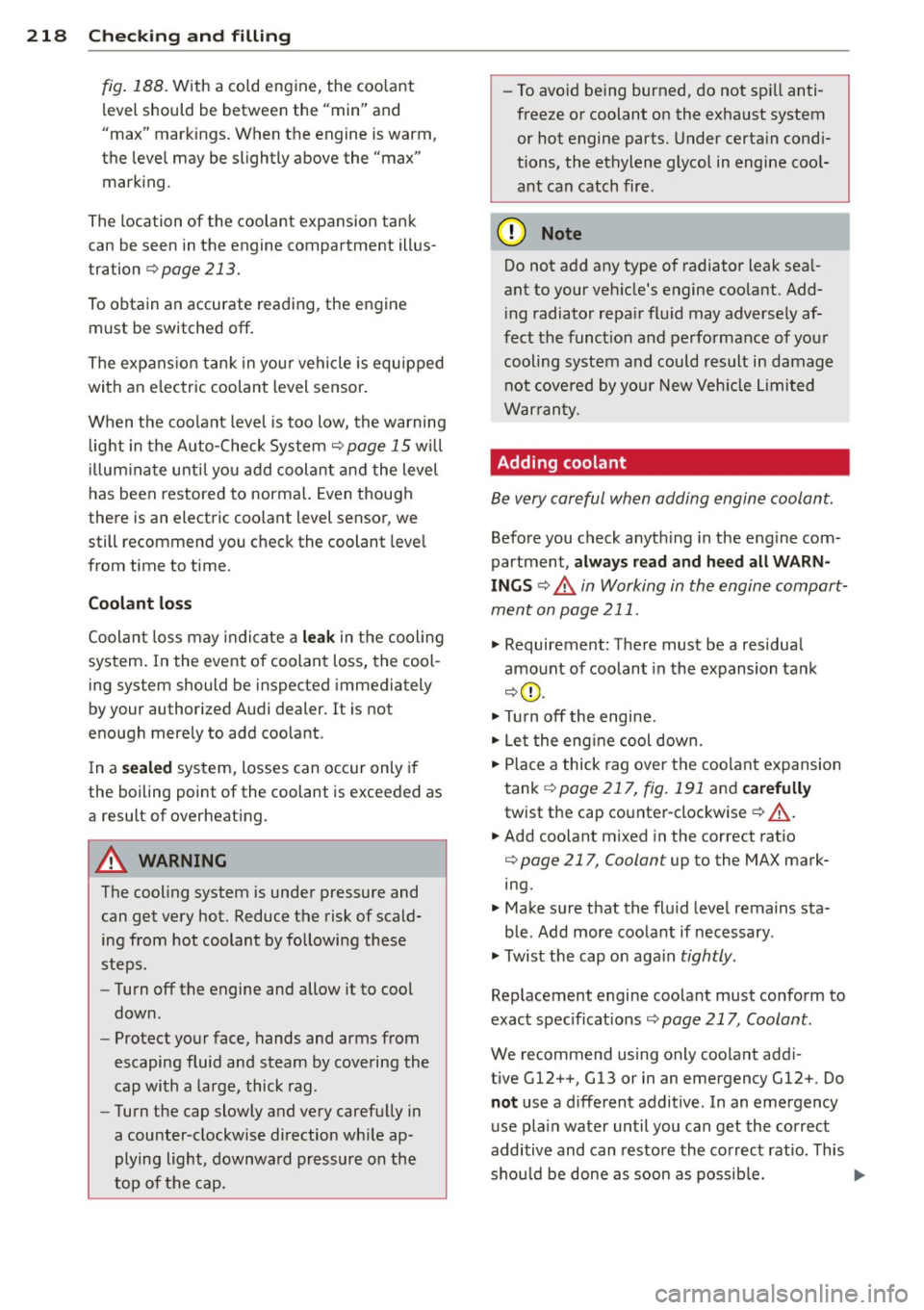
218 Check ing and filling
fig . 188. With a cold engine, the coo lant
l evel should be between the "min" and
"max" markings . When the engine is warm ,
the leve l may be slightly above the "max"
mark ing .
The location of the coolant expansion tank
can be seen in the engine compartment illus
tration
9 page 213.
To obtain an accurate reading, the engine
must be switched off .
The expans ion tank in you r vehicle is equipped
with an e lectric coolant level sensor.
When the coolant level is too low, the warning l ight in the Auto-Check System
9 page 15 w ill
illum inate unti l you add coolant and the level
has been restored to normal. Even though
there is an electric coolant level senso r, we
still recommend you check the coolant leve l
from time to time .
Coolant loss
Coolant loss may indicate a le ak in the cooling
system . In the event of coolant loss, the cool
ing system should be inspected immediately
by your authorized Audi dealer. It is not
enough merely to add coolant.
I n a
s ealed system, losses can occur only if
the boiling point of the coolant is exceeded as
a result of overheating.
A WARNING
The cooling system is under pressure and can get very hot. Reduce the risk of scald
ing from hot coolant by followi ng these
steps .
- Turn off the engine and allow it to coo l
down.
- Protect your face, hands and arms from
escaping fluid and steam by covering the
cap with a large, thick rag .
- Turn the cap slowly and very carefu lly in
a counter-clockwise direction w hile ap
plying light, downward pressure on the
top of the cap . -
To avoid being burned, do not spi ll anti
freeze or coolant on the exha ust system
or hot engine parts. Under certain cond i
tions, the ethylene glycol in engine coo l
a nt can catch fire.
(D Note
Do not add any type of radiator leak sea l
ant to your veh icle's engine coolant. Add
i ng radiator repair fluid may adverse ly af
fect the funct ion and pe rformance of you r
cooling system and could result in damage
not cove red by your New Veh icle Limited
War ran ty.
Adding coolant
Be very careful when adding engine coolant.
Befo re you check anyth ing in the eng ine com
partment,
always read and he ed all WARN
INGS ¢ ..&. in Working in the engine compart
ment on page
211.
" Requirement: There must be a residua l
amo unt of coolant in the expansion ta nk
¢ (D .
"Tu rn off the engi ne.
" Le t the eng ine cool down.
" Place a thick rag over the coolant expansion
t ank
9 page 217, fig. 191 and ca refully
twist the cap counter-clockwise ¢&,, .
" Add coolant m ixed in the correct rat io
¢
page 217, Coolant up to the MAX mark
ing.
" Make sure that the flu id leve l remains sta -
ble . Add more coo la nt if necessary .
" Twist the cap o n again
tightly .
Replacement engine coo lant must conform to
exact spec ificat ions ¢
page 217, Coolant.
We recommend using only coolant add i-
tive
Gl2++, Gl3 or in an emergency Gl2 +. Do
not use a d ifferent addit ive . In an emergency
use p la in water until you can get the correct
additive and can resto re the co rrect rat io . This
shou ld be done as soon as possib le. .,..
Page 231 of 302
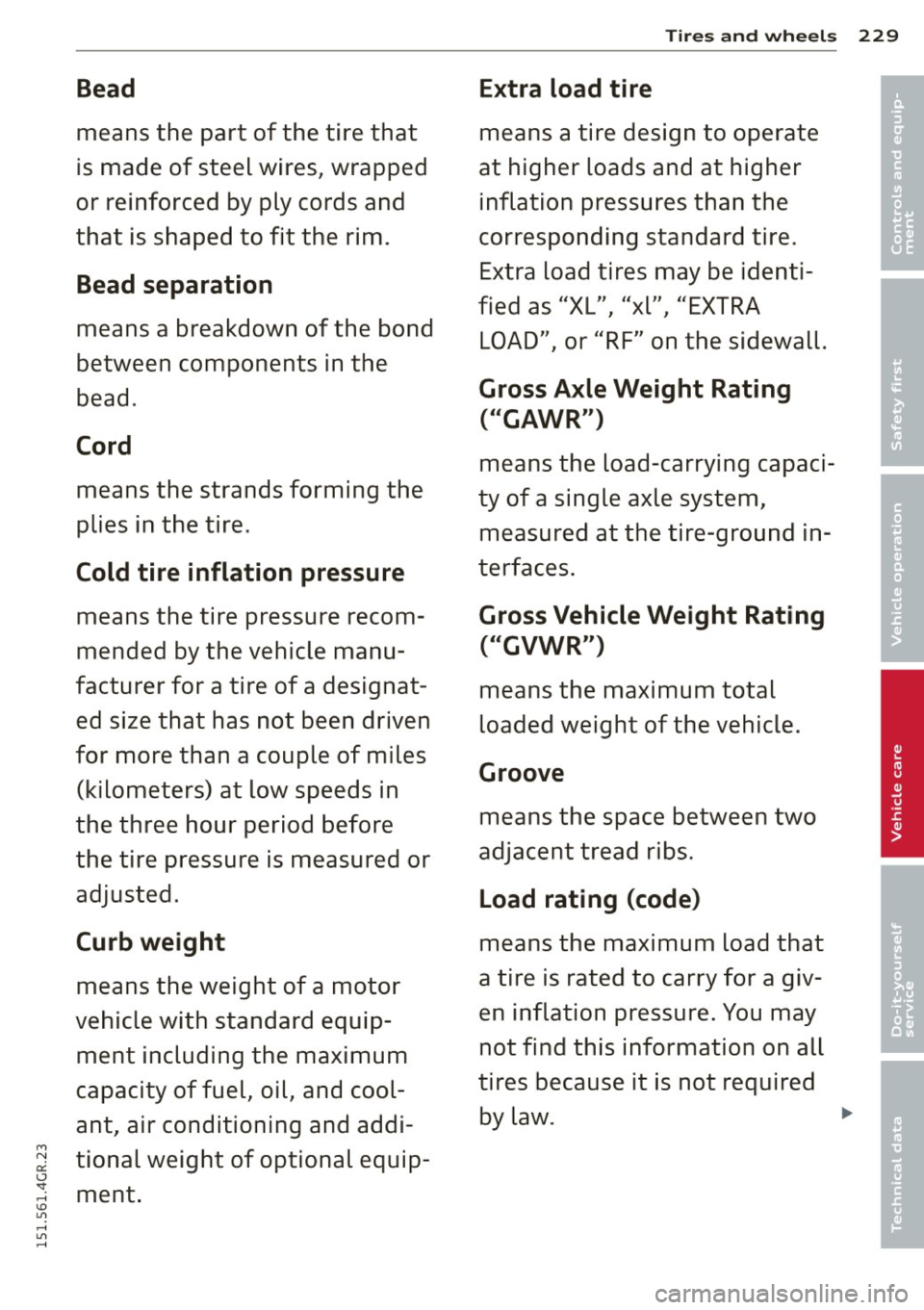
Bead
means the part of the tire that
is made of steel wires, wrapped
or reinforced by ply cords and
that is shaped to fit the rim .
Bead separation
means a breakdown of the bond
between components in the
bead.
Cord
means the strands forming the
plies in the tire.
Cold tire inflation pressure
means the tire pressure recom
mended by the vehicle manu
facturer for a tire of a designat
ed size that has not been driven
for more than a couple of miles (kilometers) at low speeds in
the three hour period before
the tire pressure is measured or
adjusted.
Curb weight
means the weight of a motor
vehicle with standard equip
ment including the maximum
capacity of fuel, oil, and cool
ant, air conditioning and addi
tional weight of optional equip
ment.
Tires and wheels 229
Extra load tire
means a tire design to operate
at higher loads and at higher inflation pressures than the
corresponding standard tire. Extra load tires may be identi
fied as "XL", "xl", "EXTRA
LOAD", or "RF" on the sidewall.
Gross Axle Weight Rating ("GAWR")
means the load-carrying capaci
ty of a single axle system,
measured at the tire-ground in
terfaces.
Gross Vehicle Weight Rating ("GVWR")
means the maximum total
loaded weight of the vehicle.
Groove
means the space between two
adjacent tread ribs.
Load rating (code)
means the maximum load that
a tire is rated to carry for a giv
en inflation pressure. You may
not find this information on all
tires because it is not required by law.
•
•
'